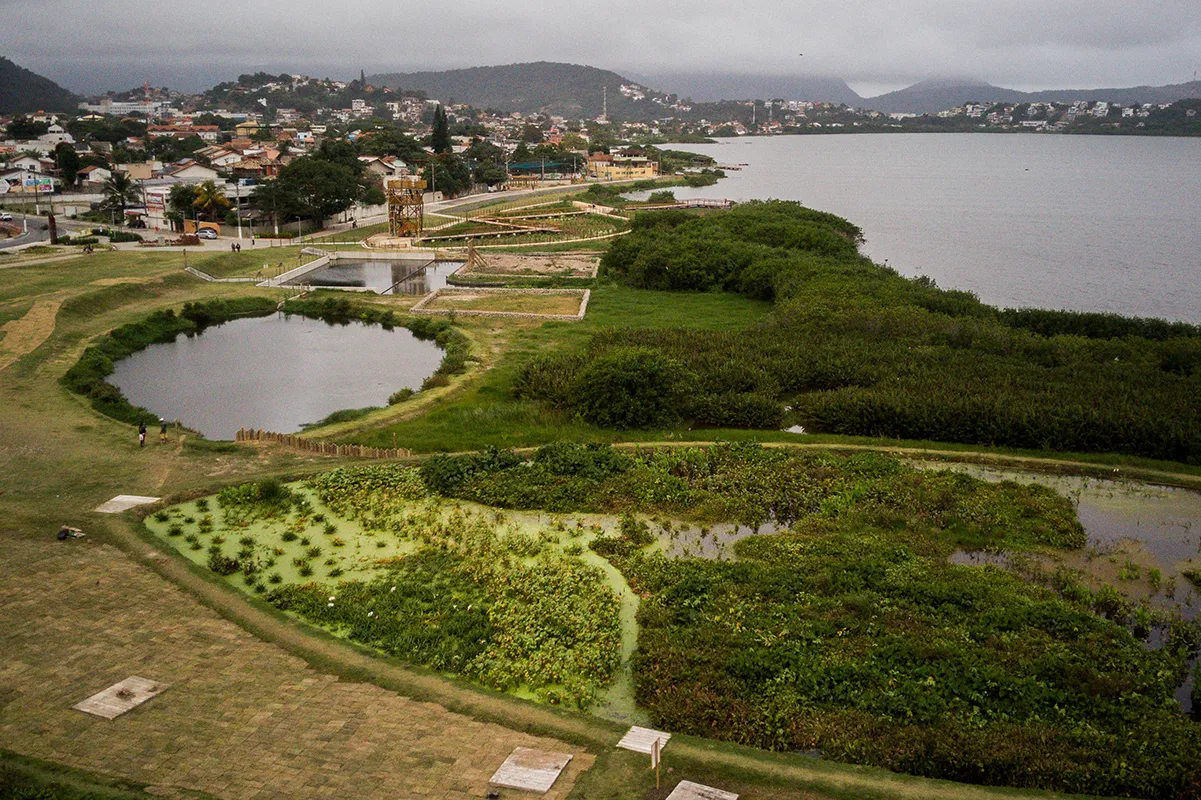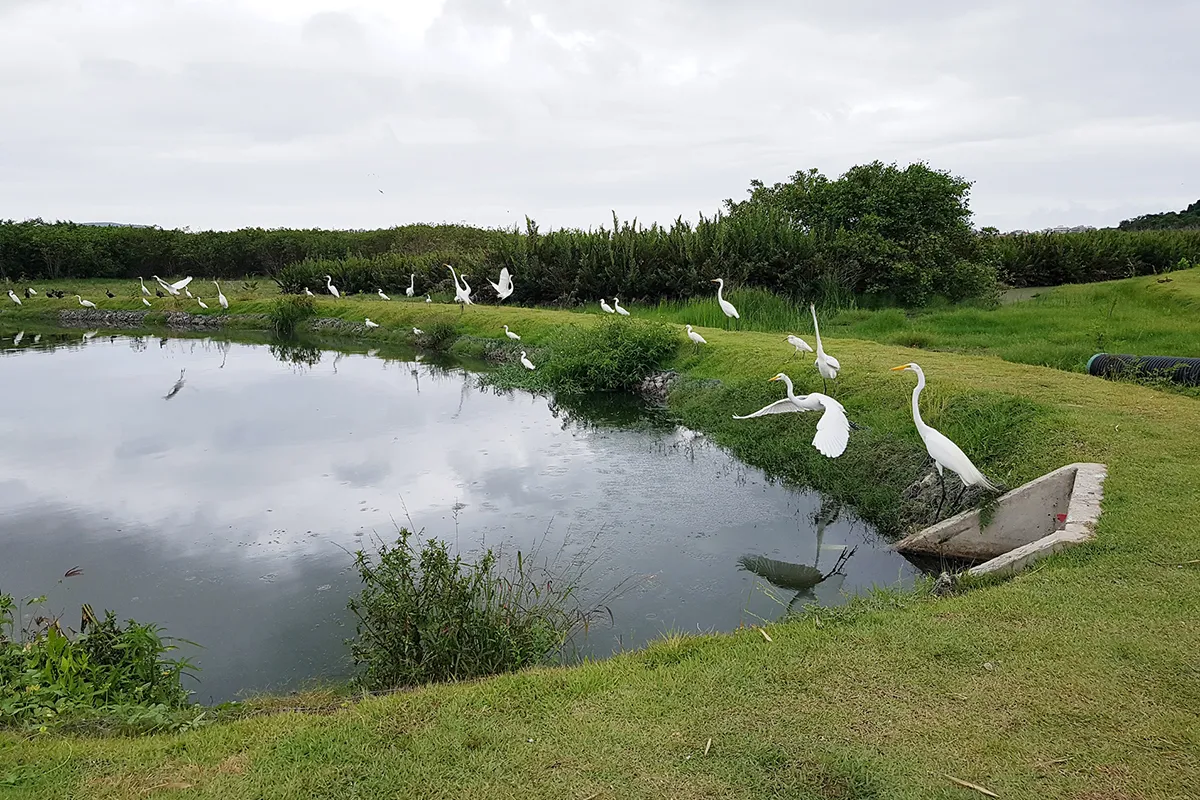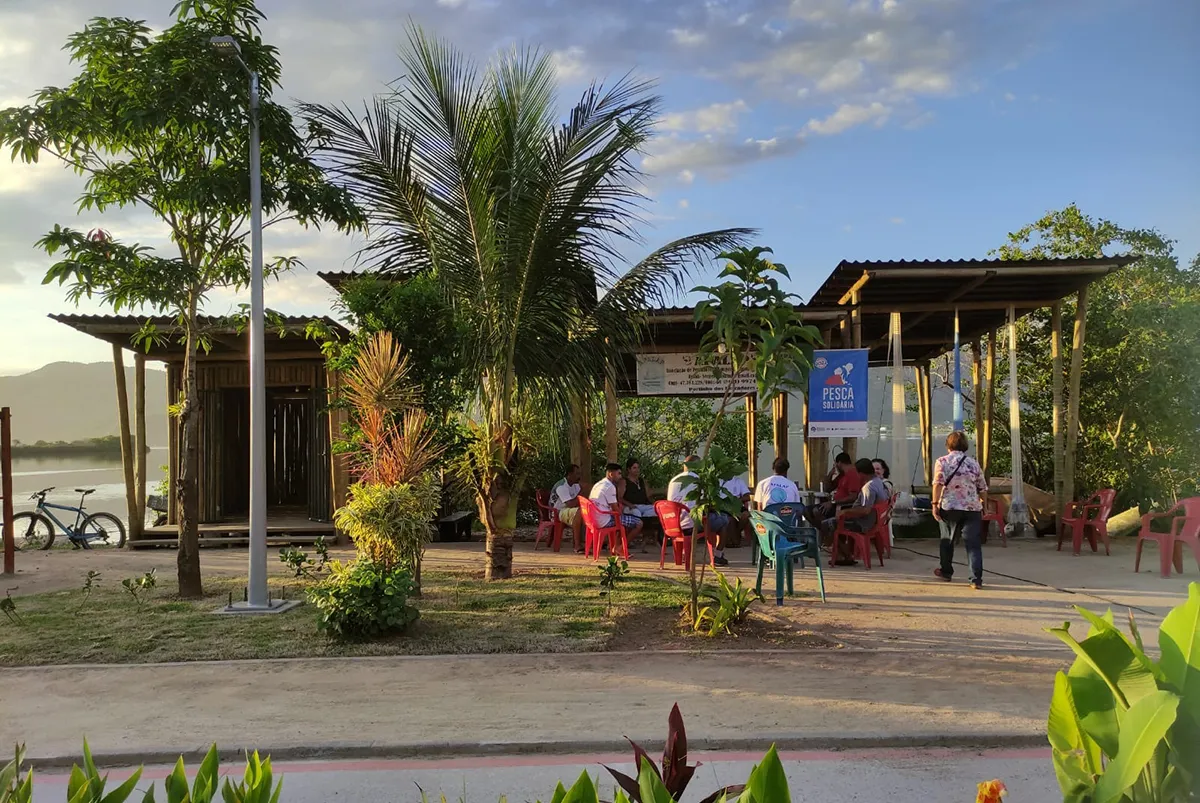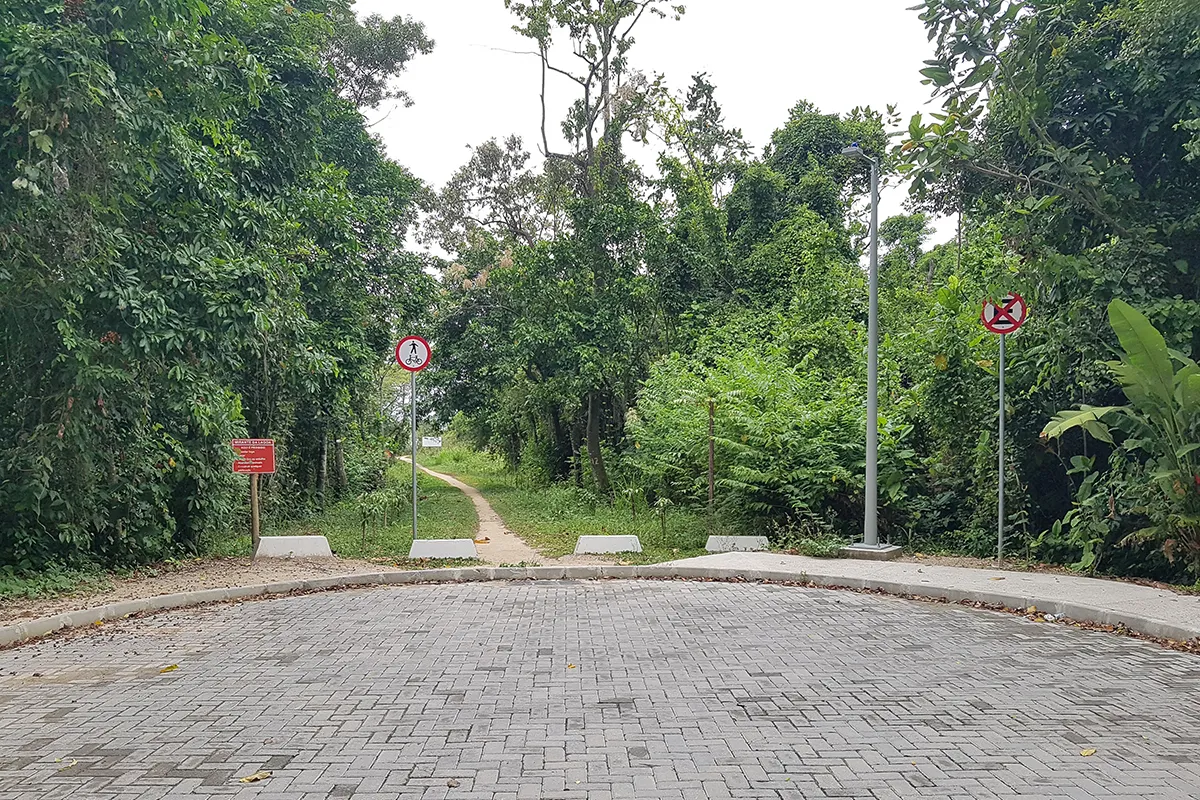Benefits of Urban Greening
Harnessing the Power of Plants
Through green structures such as filter gardens, biovalets, ecological landscaping and plant enrichment, the POP contributes to the provision of regulatory, cultural and support services throughout the Piratininga Lagoon. It was shaped by bioengineering works, adopting nature-based solutions – SBN, with the main objective of treating the waters of the three rivers that contribute to the Piratininga Lagoon. As well as those of surface runoff through aquatic macrophytes, which are plants adapted to environments with varying concentrations of nutrients successfully used in the recovery of polluted rivers and lakes as they have a high phytoremediation potential, contributing to the natural self-depuration of eutrophied effluents in water bodies.
As for the ecosystem services observed, the regulation and provisioning services stand out, as the improvement in the quality of the water entering the Piratininga Lagoon, from the phytoremediation of the filtering gardens, is already influencing the increase in fish numbers, as fishermen have reported. The planting and recovery of degraded areas contributes to carbon sequestration and biogeochemical cycles such as nitrogen, hydrogen and phosphorus. Cultural services include the wellbeing and benefits provided by ecosystems, such as leisure, rest, meditation, physical activity, contemplation, tourism, environmental education, and contact with nature and the environment.
Delivering Multiple Benefits
To exploit the potential of plants and the ecological interaction with wildlife, the POP planting used botanical species native to Brazil to enrich the areas undergoing environmental recovery, the banks of the lagoon, squares, bioswales, gardens, streets, as well as the diversity of macrophyte species to make up the filter garden systems. In this case, the rapid development of these species has provided a favourable environment in a short period of time for the availability of food, shelter and nesting for various species, as well as for the phytoremediation of the eutrophied effluents. The botanical biodiversity introduced into the filter gardens with apparent water depth and an abundance of fish, molluscs, plankton and amphibians was essential for attracting insects, birds and reptiles.
The City’s Bold and Innovative Vision
The POP is the largest urban public park in Brazil, adopting NBS to treat the water that enters the Piratininga Lagoon from surface runoff and the conventional drainage network. Systems thinking as a theoretical premise in the management process, involved residents in the entire process of building the POP from its initial conception to the implementation of the works. This meant that the POP was appropriated by people from different socio-economic backgrounds, resulting in a context of territorial/environmental justice. In this way, the POP has become a benchmark in urban environmental sustainability and also in public management.
Partnerships and Collaboration
The POP is an innovative project that seeks applicability outside of traditional engineering and is based on the premise of using NBS. As such, the challenges require a multidisciplinary team working in a transdisciplinary way from the conceptual design, through the basic and executive projects to the implementation phase of the works, with the ability to create solutions for unexpected events, which was a constant given the innovative nature of the POP. The team is currently made up of engineers, architects, biologists, geographers, psychologists, administrators, social communicators, lawyers and graphic designers.
Addressing Urban Challenges
The Issue
The POP was set up in a very degraded area, where sewage, domestic waste and construction waste were dumped. As a result, residents didn’t go near it because they considered it inhospitable. It was also considered dangerous due to its proximity to a socially vulnerable population with evidence of drug trafficking.
The Impact of the Issue
The POP seeks to reverse the historical process of environmental degradation of the Piratininga Lagoon and its surroundings since the area has been totally abandoned, causing sanitary and public health problems for residents, as well as significant impacts on wildlife due to environmental degradation.
A Nature-Orientated Future
The issue has been completely reversed. The POP now attract residents from the surrounding area and from other parts of the municipality of Niterói, who have started to enjoy and share this new landscape. It is worth noting that in addition to the constructed wetlands and filter gardens, NBS make a decisive contribution to the recovery and protection of specific ecosystems and areas that connect different ecosystems. The irreversibility of the hour-long process is also considered, given the sense of belonging expressed by local residents and the technical-scientific research already carried out by academic communities.
Through NBS, it is possible to treat the surface runoff and drainage water that enters the Piratininga Lagoon. In addition to increasing biodiversity and promoting conditions for the recovery and preservation of the region’s native animal and plant species. The POP offers the population a public urban park made up of filtering gardens, Atlantic Forest connectors with preserved mangroves, a bike path, two leisure and sports centres, support structures for fishing activities, piers for fishing and contemplation, squares and viewpoints. Thus, considerably reducing the social inequalities that were previously present.
Nature Positive Solutions
Implementation
The positive environmental impacts of the Cafubá filter garden system, first to be completed, have been identified and recorded by the local population, in addition to the improvement in the quality of the water of the lake from phytoremediation.
The positive impacts include:
- a significant reduction in mosquitoes, even in nearby residences, due to the environmental conditions for the regeneration of the trophic levels of the food chain;
- reduction of the organic load and contribution of sediments thrown into Lagoa Piratininga, with proper retention not dumped in the sedimentation basin;
- a significant increase in birdlife, which has identified an environment of refuge, feeding, reproduction and nesting.
Feasibility
The project began with a loan agreement with the Development Bank of Latin America (CAF) and is currently being paid for with Niterói City Hall’s own funds. It also relies on interdepartmental technical cooperation. In addition, a tender is currently underway to hire a company to carry out the maintenance of the POP.
Multi-Stakeholder Support
The POP, like all Sustainable Oceanic Region Program (PRO Sustentável) projects, is based on systemic thinking. As such, it takes into account the participation of local residents throughout the entire work process, from drawing up the project to carrying out the work. During the executive project phase, several meetings were held with local residents and 85% of the requests made were met. In addition, five structures were built to cater for the different groups of fishermen who also helped with the location of the fishing piers. The POP also receives monthly technical visits from universities, political leaders and managers to encourage research and disseminate information to the entire population.
Management and Maintenance
To ensure that the POP is fully utilised and its structures properly maintained, the Sustainable Management and Operation Project is structured to maintain the green infrastructures that have been built, as well as making full use of the public spaces that have been set up. The Niterói City Council, using non-reimbursable funds from Technical Cooperation with the Latin American Development Bank (CAF), has contracted the PLANTUC Consortium to structure an Integrated Project that will enable the necessary studies to be carried out to grant the implementation, operation, maintenance and sustainable management of the POP in partnership with the private sector.
Measuring and Reporting Impact
Monitoring Results
Water quality monitoring began when macrophytes were planted in the Cafubá filter garden system in September 2022. Water quality samples are collected monthly and currently 12 chemical parameters are assessed in the laboratory and four physical-chemical parameters are measured in the field. From August 2023, after the macrophytes were planted in the Arrozal system, water sampling also began in this system. Water samples are collected at the inlet (spillway), in the sedimentation basins and at the outlets of the filter gardens. As a result of the phytoremediation carried out by the macrophytes, the water from the contributing rivers that passes through the filter garden systems and enters the Piratininga lagoon arrives with lower concentrations of pollutants, thus presenting better environmental quality. It is inferred that the filter gardens are already resulting in this improvement based on the results presented and the increase in local biodiversity.
Demonstrating Progress
From the results of monitoring and the increase in local biodiversity, the filter gardens, based on phytoremediation of macrophytes, are effective in improving water quality. Studies and research into filter garden systems are being promoted so that these and other NBS can be implemented not only in the Piratininga lagoon but also in other bodies of water in the municipality of Niterói. It is worth noting that engineering works are currently being carried out using NBS with the aim of renaturalising the Jacaré river basin. NBS projects are also being drawn up for future implementation in the Itaipu lagoon.
Measuring Impact
The water quality of the Cafubá filter garden system has been monitored since September 2022, with samples taken at the system’s inlet (spillway) and outlet (outfall). Initially, 16 physical-chemical parameters were analysed. In that month, high concentrations of parameters indicating contamination by organic matter, such as biochemical oxygen demand (BOD), total dissolved solids (TDS) and coliforms, were identified at the system’s outlet, which did not comply with CONAMA 357 resolution. From the campaign carried out in March/2023, the heavy metal parameters ( Cadmium and Zinc) were suspended due to their values being below the quantification limit. From April/2023 onwards, the physical-chemical parameters temperature, dissolved oxygen (DO) and oils and grease were included. The following analyses showed a continuous reduction in nitrate, total organic carbon (TOC), BOD, chlorophyll a and solids. The coliform parameter showed variable values, but reached concentrations in line with legislation. Thus, by comparing the results of the system’s outlet samples over this monitoring period, it was possible to see a reduction in values, indicating the system’s efficiency.
Learning and Transferability
Adaption and Enhancement
Even during the executive design phase, changes were made based on requests from local residents, and it was possible to meet around 85% of the demands. As for the changes made during and after the works, there was a need for structural changes such as increasing the water depth in the filter gardens to better adapt the macrophytes and balance the trophic web formed in these systems. There was also a need to increase the number of boreholes in the areas planned for the construction of the filter garden system, as well as the need to fence off a certain area where the young of the yellow-bellied caiman (Caiman latirostris) were identified, in order to protect them. This area was later defined as an alligator nursery. In Estrela Street, in the Piratininga neighbourhood, where it was planned to build lots to be landfilled and built on, a change of use was necessary to preserve the rich biodiversity. In view of the special intangible ecosystem value of this stretch, which is a natural ecological corridor between the City Park and the POP, i.e. the Atlantic Forest and the wetlands next to the Piratininga Lagoon, it was necessary to reconsider the project to guarantee the protection and conservation of these wetlands.
Potential for Replication
With the implementation of the POP, there has been a strong demand from visitors from various regions of Brazil, as well as mayors from Portugal, whose main reason for visiting is to learn about the filter garden systems and the plant species involved in phytoremediation. Visitors include universities, municipal and state departments, private companies and non-governmental organisations. The park is already showing significant results, which can be seen in the behaviour of the population benefiting from the sanitation works. Mosquitoes, which used to be controlled by the local population using bonfires in the late afternoon, are now controlled by natural predator species attracted by the filter gardens. Currently, in the areas that have been planted with macrophytes as well as tree and shrub species, there has been an increase in the number of birds, and local residents are even questioning whether the project has brought birds to the area. The transfer of valuable knowledge is guided by the exchange of experiences between residents and the teams involved in setting up the park, whose records contribute to the adjustments made to the project. For example, the region’s artisanal fishing culture was provided with five fishing support structures, based on the fishermen’s demands, which they now use to store and maintain their boats.
Inspiring Other Cities
Even before the official completion and inauguration of the Cafubá filter gardens, several managers, mayors and members of the scientific community scheduled visits to the POP. After the inauguration and with the award at the Smart City Expo Latam Congress in May 2023, the POP increased its visibility and was even mentioned in the Cidades Soluções program, becoming a reference in SBN in Brazil.
Resilience
Reducing Negative Impacts and Ensuring Sustainability
The POP contributes to climate adaptation by controlling the quality of the water that enters the Piratininga lagoon. Through phytoremediation, the planting of 158,000 m² of vegetation and the planting of tree species for recovery and botanical enrichment, it contributes to the sequestration of carbon and other biogeochemical cycles, such as nitrogen, hydrogen and phosphorus.
Environmental Considerations
As the POP is located on the shores of the Piratininga Lagoon, which over time has suffered from the impacts of disorganised population growth and whose basic sanitation has not kept pace with the progress of construction in the region, the initiative to build a park in an urban environment had the general objective of helping to reverse the process of environmental degradation in the Oceanic Region. It did this by reclaiming and ecologically restoring degraded areas, mitigating and adapting to climate change, improving urban mobility, reducing unhealthy conditions in local neighbourhoods and increasing the wellbeing of the local population by implementing appropriate urban, environmental and road infrastructure. The planting of botanical species native to Brazil focuses on the ecological functions of feeding, sheltering, reproducing and nesting wildlife, as well as enhancing scenic beauty and the wellbeing of the population. The phytoremediation carried out by the macrophyte plants provides advances in the quality of the water that enters the lagoon and all the biomass from the maintenance of the filter gardens is destined for composting, closing the cycle of sustainability in this environment.
Use of Natural Resources
The POP has a wildlife observatory, which consists of a higher level near the alligator nursery, measuring approximately 1200m². This area, as well as the paragliding landing strip and the entire surroundings of the filter gardens, was built using material from the excavations at the site itself. Around 1560 m³ of soil was reused, avoiding its disposal. These areas have been levelled and grassed for public walks, sports and contemplation. The filtering gardens are also composted to properly dispose of the biomass that comes from maintaining the plants, whose final destination is the park’s gardens and squares. We also have a rainwater harvesting system for use in the toilets at the EcoCultural Center, which is in the final stages of construction.


























